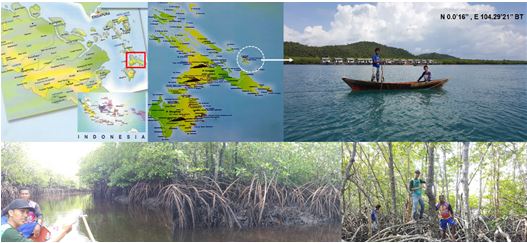
Traditional Ecological Knowledge on Mangrove Ecosystem Utilization: Learning from Orang Suku Laut Kongky Strait, Lingga
Abstract
Traditional Ecological Knowledge (TEK) has eroded globally, particularly which related to ecology. Even though TEK has been recognized as crucial for a sustainable development perspective. This study aims to explore TEK of Orang Suku Laut (OSL) Konky Strait in Lingga about the utilization of mangrove ecosystem. Research area is Konky Strait which is a part of Lingga Regency, Riau Archipelago Province. Data was collecting by using document study, field study, in-depth interviews, meetings and group interviews, participatory and non-participatory observation techniques. There are at least eight species of flora and 17 species of fauna that are known by OSL in Konky Strait. Taxonomically, flora which has been utilized are classified in 6 families, while fauna consist of 15 families. The types of flora are generally utilized for firewood, building materials, fisheries infrastructure (fishing gear) and traditional medicine for health. While the whole fauna species used as food sources. Almost all mangrove flora parts are used such as trunk, branches, leaves, flowers, fruits, shoots, and roots. It can be concluded that Orang Suku Laut Konky Strait have traditional ecological knowledge in the management of mangrove ecosystems in a sustainable manner.
Keywords
Full Text:
PDFReferences
Adidtia, P., Idham, M. & Iskandar. (2018). Kearifan Lokal Masyarakat Desa Sungai Bakau Besar Laut dalam Pengelolaan Hutan Mangrove Kecamatan Sungai Pinyuh Kabupaten Mempawah. Jurnal Hutan Letari 6 (1): 223-229.
Aswani, S., Lemahieu, A & Sauer, W.H.H. (2018). Global trends of local ecological knowledge and future implications. PLOS ONE https://doi.org/10.1371.
Bahta, S. (2017). Promotion of Indigenous Knowledge through Scientific Research is Fundamental to Sustainable Development: An Anthropological Perspective. Sociology and Anthropology 5 (9): 776-780. DOI: 10.13189/sa.2017.050909
Balsiri, N. (2014). Restoration and Conservation of Ecological System, Way of Life, and Local Wisdom of Mangrove Forest Community. Proceeding of The 3rd International Conference on Informatics, Environment, Energy and Applications Vol. 66., pp. 97-101. DOI: 10.7763/IPCBEE.
Cajete, G. (2018). Native Science and Sustaining Indigenous Communities. In. Nelson, M.K and, Shilling, D (Eds.). Traditional Ecological Knowledge: Learning from Indigenous Practices for Environmental Sustainability, pp. 15-26. Cambridge University Press, UK. DOI: 10.1017/ 9781108552998.
Carter, L. (2019). Traditional Ecological Knowledge in Climate Change. Indigenous Pacific Approaches to Climate Change, pp 25-38. Palgrave Studies in Disaster Anthropology. https://doi.org/10.1007/978-3-319-96439-3_3
Chou, C., & Wee, V. (2002). Tribality And Globalization- The Orang Suku Laut and the “Growth Triangle” in a Contested Environment. In. Benjamin, J and Chou, C. (Eds.) Tribal communities in the Malay World: historical, cultural and social perspectives. Institute of Southeast Asian Studies, Singapore, 318-363.
Chou, C. (2003). Indonesian Sea Nomads, Money, Magic, and Fear of The Orang Suku Laut. RoutledgeCurzon, London.
Citra, P. (2019). Local Wisdom Coastal Communities in Rural Bajo Pohuwato Regency, Gorontalo Province, Indonesia. International Journal of Innovative Science and Research Technology 4 (1), 689-691.
Diandara, O., Samsuddin, S., Irmawati, S., Aris, D. N., Jamaluddin, J., Abdul, M., & Syamsul, B. (2018). Duano’s Local Wisdom in Preserving Marine Ecosystem at Jambi Coastal Area . IOP Conf. Series: Earth and Environmental Science 175, doi :10.1088/1755-1315/175/1/012227.
Evawarni, dan Sindu Galba. (2005). Kearifan Lokal Masyarakat Adat Orang Suku Laut di Kepulauan Riau. Balai Kajian Sejarah dan Nilai Tradisional, Tanjungpinang.
Farid Aulia. (2016). Kearifan Lokal dalam Pengelolaan Hutan Mangrove Secara Berkelanjutan. Prosiding Seminar Nasional Pelestarian Lingkungan dan Mitigasi Bencana. 28 Mei 2016. Universitas Riau. Pekanbaru.
Finn, S., Herne, M and Castille, D. (2017). The Value of Traditional Ecological Knowledge for the Environmental Health Sciences and Biomedical Research. Environmental Health Perspectives. A Section 508–conformant HTML version of this article is available at https://doi.org/10.1289/EHP858...
John, K. A. (2017). Bapongka, Sistem Budaya Suku Bajo Dalam Menjaga Kelestarian Sumber Daya Pesisir. Sabda, 12 (1), 52-69.
Khidir, M. (2010). Orang Suku Laut dan Orang Melayu di kepulauan Riau: Sebuah Tafsir Deskriptif-Etnografis. Antropologi Indonesia, 31 (3), 224-239.
Kimmerer, R.W. (2002). Weaving Traditional Ecological Knowledge into Biological Education: A Call to Action. BioScience, 52 (5), 432-438.
Magni, G. (2016). Indigenous Knowledge And Implications For The Sustainable Development Agenda. Global Education Monitoring Report ED/GEMR/MRT/2016/P1/20. UNESCO
Mekonen, S. (2017). Roles of Traditional Ecological Knowledge for Biodiversity Conservation. Journal of Natural Sciences Research, 7(15), 21-27.
Miswadi, Ramses Firdaus, dan Romie Jhonnerie. (2017). Pemanfaatan Kayu Mangrove oleh Masyarakat Suku Asli Sungai Liong Pulau Bengkalis. Dinamika Maritim, 6 (1), 35-39.
Nugraha, Y.S. (2019). Mengenal Petuah, Serapah, Jampi, Mantra dan Doa dalam Tubuh Melayu. Available at https://jantungmelayu.com/2017/01/mengenal-petuah-serapah-jampi-mantra-dan-doa-dalam-tubuh-melayu/ (Retrieved on Sept 26/9/2019).
Ramli Utina. (2012). Kecerdasan Ekologis Dalam Kearifan Lokal Masyarakat Bajo Desa Torosiaje Provinsi Gorontalo. Prosiding Konferensi Dan Seminar Nasional Pusat Studi Lingkungan Hidup Indonesia Ke 21, 14-20
Safakish, M. (2015). The Role of Indigenous Knowledge In Sustainable Rural Economic Development. J. Appl. Environ. Biol. Sci., 5(9S), 285-289.
Sony, K., A. (2010). Etika Lingkungan Hidup. PT Kompas Media Nusantara. Jakarta
Undang-Undang Republik Indonesia Nomor 32 Tahun 2009 Tentang Perlindungan dan Pengelolaan Lingkungan Hidup.
Wengki, A., & Limjirakan, S. (2019). Traditional Ecological Knowledge of Indonesian Sea Nomad “Orang Suku Laut” on Cimate Change Adaptation. Proceeding on the 5th EnvironmentAsia International Conference, 25-35.
DOI: http://dx.doi.org/10.31258/jes.3.3.p.328-339
Refbacks
- There are currently no refbacks.
Copyright (c) 2019 L.N. Firdaus, Rizki Ma’ruf, Elmustian Elmustian, Suarman Suarman, Ridwan Melay

This work is licensed under a Creative Commons Attribution 4.0 International License.
Publisher: FKIP Universitas Riau













